Shiplap has revolutionized interior design over the past decade, transforming ordinary bedrooms into magazine-worthy sanctuaries with its distinctive horizontal wooden panels.
What was once a practical building material used in coastal homes has become one of the most sought-after design elements for creating character and warmth in modern spaces.
There’s something undeniably charming about the subtle shadow lines between each wooden board that adds dimension and texture where flat drywall falls short.
The beauty of shiplap lies in its ability to simultaneously feel rustic yet refined, lived-in yet luxurious—the perfect contradiction for bedroom spaces where comfort meets style.
If painted crisp white, left naturally weathered, or transformed with unexpected colors, these wooden panels instantly elevate any bedroom they grace.
If you’re on the fence about this design trend, prepare to be convinced.
These TOP shiplap ideas might just inspire your next weekend project!
✨Click to Get My 101 FREE Designer Room Ideas
Classic Horizontal Shiplap
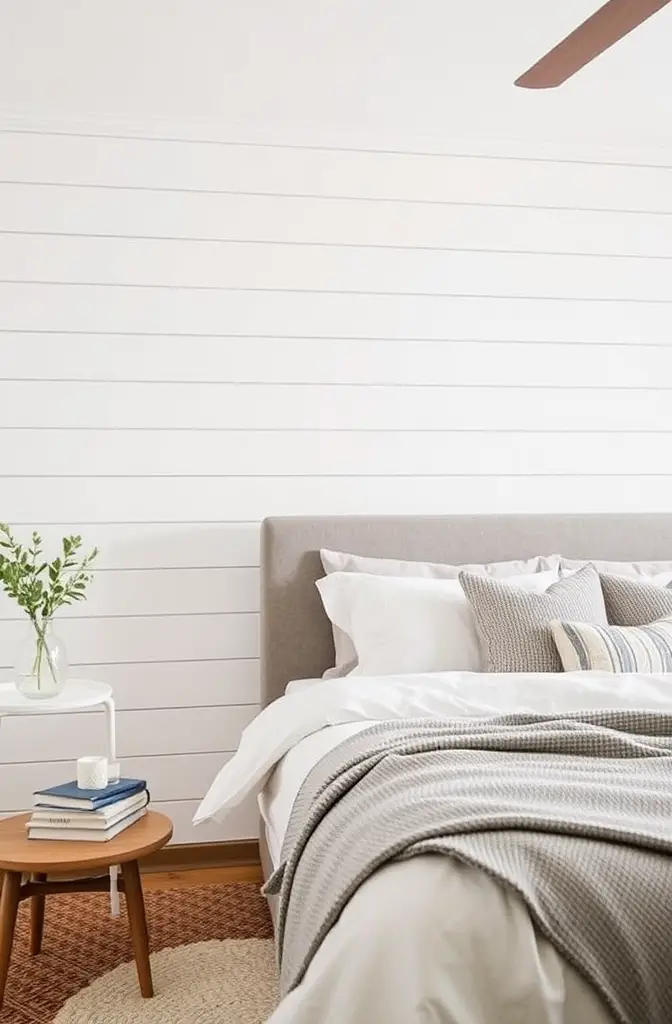
Nothing beats the traditional horizontal installation when you’re first diving into the shiplap world.
🌊
The linear pattern naturally draws your eye across the wall, creating an optical illusion that expands your space.
This approach works absolute wonders in smaller bedrooms where every visual trick counts.
The subtle shadow lines between each board add dimension without overwhelming the senses.
You can achieve this look with real wood boards, cost-effective plywood strips, or even peel-and-stick options if you’re renting.
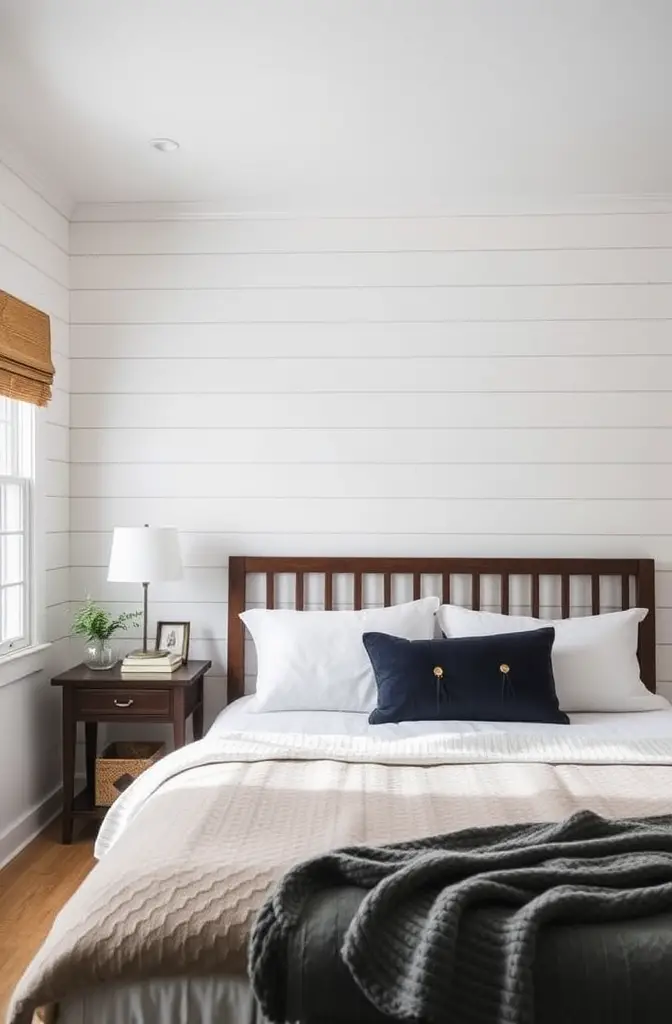
The horizontal orientation mimics the original historical purpose of shiplap—keeping harsh weather out of coastal homes—which explains why it feels so innately cozy and protective.
If you’re worried about your DIY skills, horizontal is also the most forgiving installation pattern for beginners.
Most boards come with tongue-and-groove edges that make alignment much simpler than you’d expect.
Paint-grade pine is your budget-friendly champion here, typically running $1-3 per square foot depending on your location.
For maximum impact, consider installing horizontal shiplap on the wall behind your bed, creating a natural focal point that frames your bed like a work of art.
The texture immediately adds character that flat paint simply cannot achieve, no matter how perfect the color.
Speaking of color—while white remains the classic choice, don’t be afraid to experiment with soft grays, gentle blues, or even muted sage greens to complement your bedroom’s palette.
Remember that horizontal lines can sometimes make a very tall room feel shorter, which might actually be desirable in spaces with soaring ceilings.
The gentle shadow lines create just enough visual interest to make even the simplest bedroom feel thoughtfully designed.
Consider upgrading the look with subtle lighting—picture sconces mounted directly to the shiplap for a warm, ambient glow that highlights the texture when evening falls.
✨
Vertical Shiplap: The Height-Enhancing Game Changer

Want to know the designer secret for making your bedroom ceiling feel miles higher?
👆
Vertical shiplap instantly draws the eye upward, creating a soaring effect that can transform even the most modest-height room.
This orientation breaks away from tradition in the best possible way, offering a more modern, contemporary take on the farmhouse favorite.
The vertical lines create a rhythm that feels both orderly and unexpectedly fresh in bedroom settings.
Unlike horizontal installation, vertical boards can actually make a narrow room feel more proportioned and balanced.

This approach pairs beautifully with taller headboards or four-poster beds, creating a cohesive height story throughout your space.
One practical advantage?
Dust collects less obviously on vertical boards—a small but meaningful benefit in bedroom spaces.
The installation requires a bit more precision with your measuring and leveling tools, but the dramatic results are worth the extra effort.
Consider taking the vertical boards all the way to the ceiling for maximum impact—no crown molding needed.
For a truly custom look, try varying the width of your vertical boards slightly (mixing 4″ and 6″ boards, for example) to create subtle visual texture.
The vertical orientation works particularly well with higher-grade woods like cedar or cypress where you want to showcase the natural grain patterns.
In smaller bedrooms, painting vertical shiplap the same color as your ceiling creates a continuous visual flow that removes visual boundaries.
This technique performs optical magic in attic bedrooms or spaces with sloped ceilings, making awkward angles appear intentional and architectural.
Don’t be surprised if your friends ask if you’ve actually raised your ceiling—the illusion can be that convincing!
🏠
The Statement Accent Wall: Maximum Impact With Minimal Effort

Why cover every wall when one spectacular shiplap accent wall can steal the show?
🌟
This approach gives you all the texture and character without overwhelming your space or your weekend schedule.
The accent wall strategy also significantly reduces your material costs while maximizing visual impact.

Designers consistently recommend focusing your shiplap effort behind the bed, creating a natural focal point that frames your sleeping space.
The textural contrast between one shiplap wall and standard painted walls creates an intentional design statement that looks professionally planned.
This approach allows you to experiment with bolder colors or stains that might feel overwhelming on all four walls.

The dimensional quality of shiplap provides natural interest that eliminates the need for extensive artwork or decorative elements.
Consider continuing your accent wall treatment partially up adjoining walls for a wrapped effect that feels custom and thoughtful.
This technique works equally well in master bedrooms and guest rooms, where creating a memorable impression matters.
The accent wall approach makes seasonal redecorating simpler—just change your textiles and accessories while your shiplap foundation remains timeless.
For homes with open floor plans, a shiplap accent wall can clearly define the bedroom zone without requiring actual walls.
Accent walls work particularly well when aligned with architectural features like pitched ceilings or dormer windows.
Photographers and social media influencers love shiplap accent walls because they create instant backdrop interest for outfit photos or product staging.
The depth and texture catch natural light beautifully, creating subtle shadow play that changes throughout the day.
🌞
Color-Drenched Shiplap: Beyond Basic White For Dramatic Effect
Who says shiplap has to be farmhouse white? Absolutely no one! 🎨
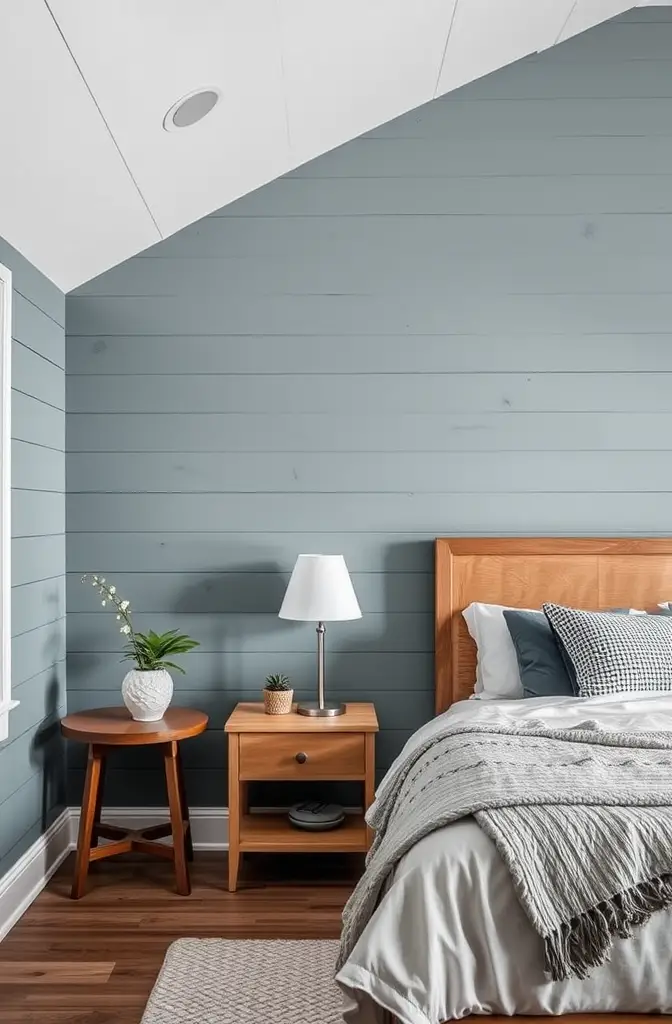
Imagine waking up surrounded by moody navy shiplap that cocoons you like a starry night.
Or perhaps a soft sage green that brings the feeling of a garden sanctuary indoors.
The texture of shiplap gives any color additional depth that flat painted walls simply cannot achieve.
Dark-painted shiplap creates an especially luxurious effect, with each shadow line between boards adding mysterious dimension.

Bold colors like emerald green, charcoal, or even black transform shiplap from country-casual to sophisticated-chic instantly.
The natural woodgrain peeking through slightly distressed paint adds character that new construction often lacks.
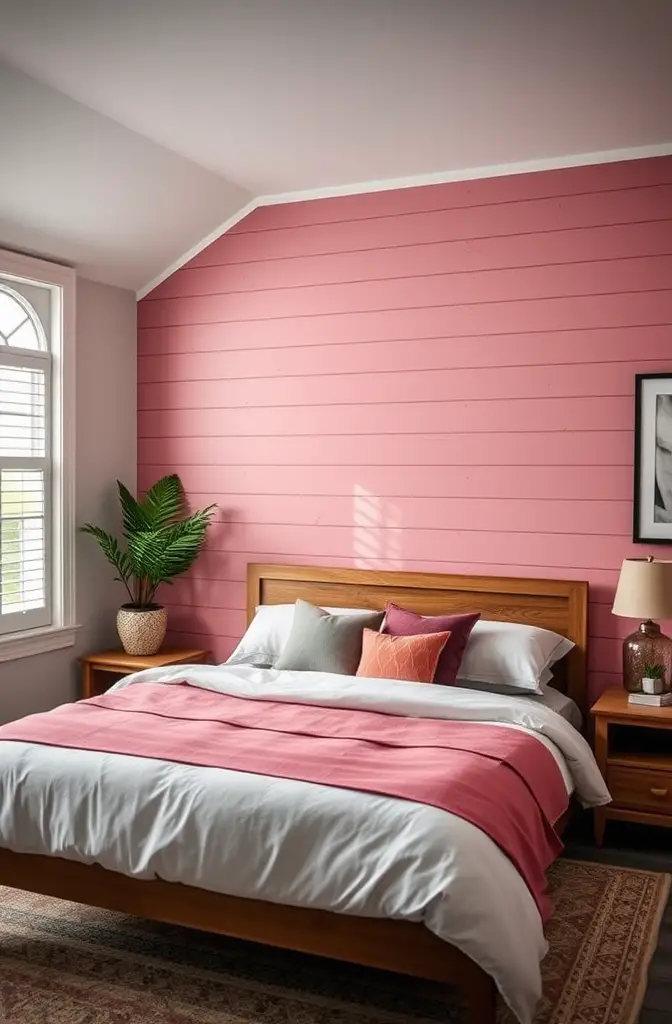
For the color-hesitant, try painting shiplap in a color just two shades deeper than your existing wall color for subtle depth.
Unexpected hues like terracotta, mustard, or dusty rose make vintage-inspired statements that feel both nostalgic and fresh.
The horizontal lines of traditional shiplap help distribute bold color choices in a way that feels intentional rather than overwhelming.
For a truly custom look, consider a color-washing technique that allows hints of wood to show through the pigment.
Bedrooms with abundant natural light can handle deeper colors that might overwhelm darker spaces.
Vibrant colors on shiplap create a perfect backdrop for neutral furnishings, allowing your bedroom’s architecture to become the statement.
Matching your shiplap color to your bedroom textiles creates a cohesive, thoughtfully designed envelope that feels instantly calming.
😌
✨Click to Get My 101 FREE Designer Room Ideas
Whitewashed Shiplap: The Beach-Inspired Dream
Transport yourself to oceanfront luxury with whitewashed shiplap that captures those carefree coastal vibes. 🏝️
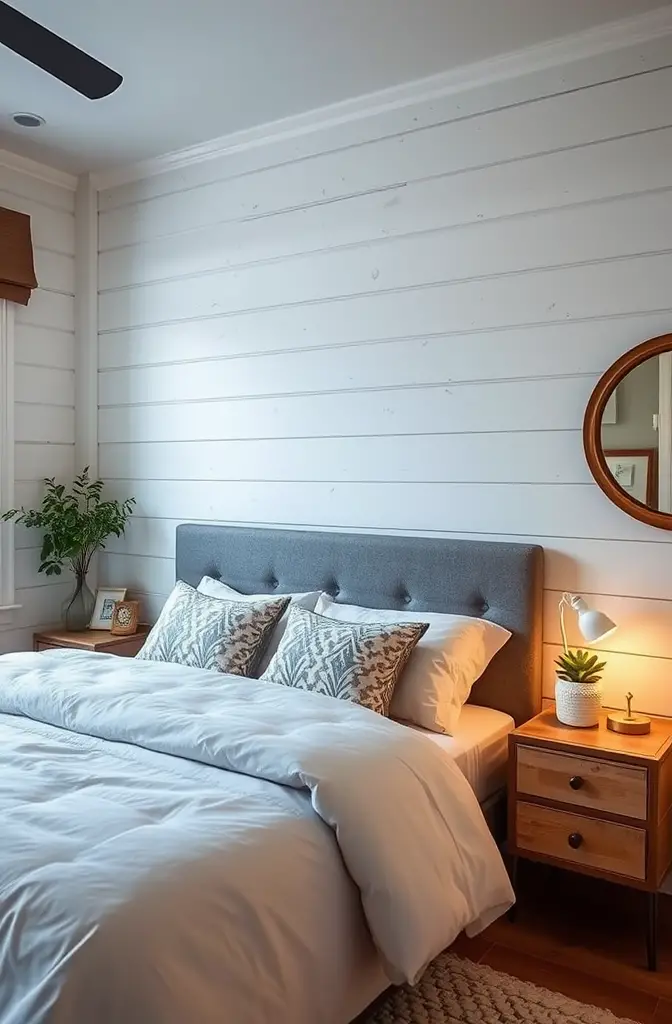
Unlike solid white paint, whitewashing allows the natural wood grain to peek through, creating depth and organic variation.
This technique works particularly well with pine, cypress or cedar boards where the natural wood patterns enhance the beachy aesthetic.
The subtle transparency of whitewash creates a luminous quality that seems to actually reflect natural light around your bedroom.
This finish bridges the gap between overly rustic and too-perfect painted surfaces, landing in that sweet spot of relaxed elegance.
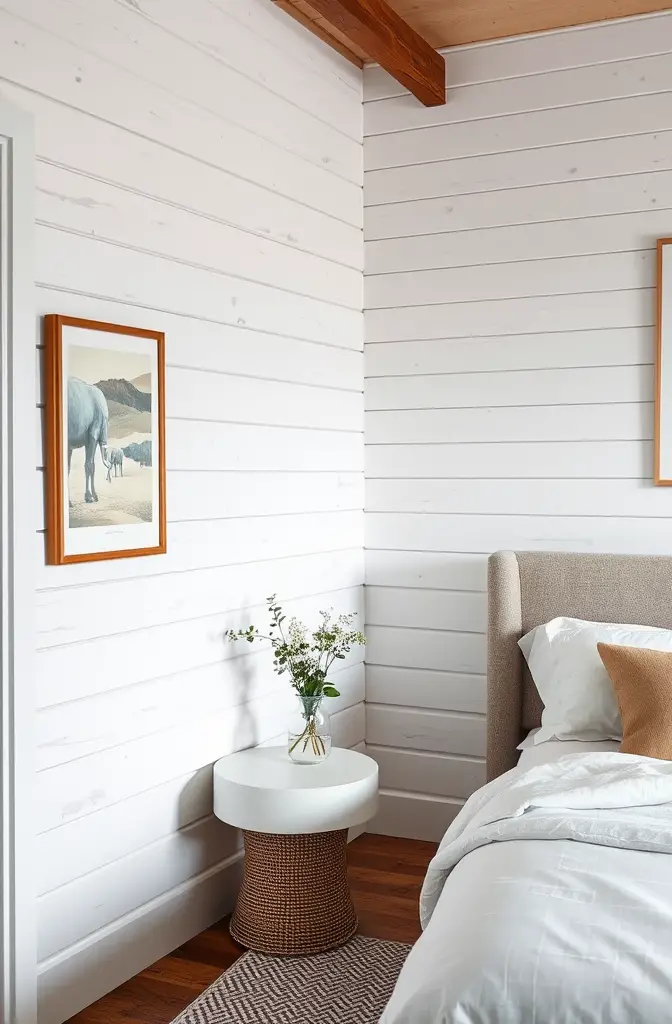
Whitewashed shiplap pairs beautifully with natural linen bedding, rattan furniture, and textural jute rugs for a complete coastal retreat.
The technique is surprisingly forgiving for DIYers—imperfections in application often enhance the weathered, sun-bleached appeal.
You can easily customize the intensity by adjusting your paint-to-water ratio or adding multiple translucent layers.
For the authentic look, choose boards with knots and natural imperfections that will show through the whitewash treatment.
This finish manages to look simultaneously current and timeless—a rare combination in the trend-heavy world of interior design.
Whitewashed shiplap creates the perfect neutral backdrop for both colorful accents and monochromatic styling approaches.
The subtle texture ensures your bedroom walls have visual interest even in minimalist settings with limited artwork or decoration.
Many homeowners report that whitewashed bedrooms genuinely improve their sleep quality by creating a space that feels lifted from a luxury beach resort.
If you’re concerned about committing to a trend, whitewashed shiplap has proven remarkable staying power in interior design.
🌊
Mixed Media: Combining Shiplap With Other Textures
Why choose between shiplap and other textures when combination creates the richest design story?

The magic happens when shiplap meets complementary elements like exposed brick, stone veneer, or even grasscloth wallpaper.
This layered approach elevates your bedroom from “one-note design” to “thoughtfully curated space” with minimal extra effort.
Consider installing shiplap three-quarters up the wall and finishing with paint or wallpaper above for sophisticated contrast.
The textural juxtaposition creates visual interest that flat paint alone could never achieve.
This approach allows you to incorporate multiple design styles—perhaps farmhouse shiplap with industrial metal accents or bohemian textiles.

Designers particularly love pairing shiplap with velvet headboards, creating a play between rough and smooth textures.
The combination technique allows you to honor older architectural elements while introducing contemporary updates.
For period homes, mixing shiplap with original plaster medallions or crown molding creates respectful renovation that honors history.
In newly constructed homes, textural combinations add instant character that normally takes decades to accumulate.
Consider using different shiplap widths or orientations in connecting spaces for subtle definition without harsh transitions.
The mixed approach allows for visual zoning in open-concept bedroom suites, defining sleeping versus dressing areas.
This technique also enables beautiful material transition points around architectural features like fireplaces or built-in shelving.
Fifth Wall Wonder: Ceiling Shiplap That Transforms Your Bedroom
Look up—your bedroom ceiling might be the blank canvas you never knew you needed! ⬆️
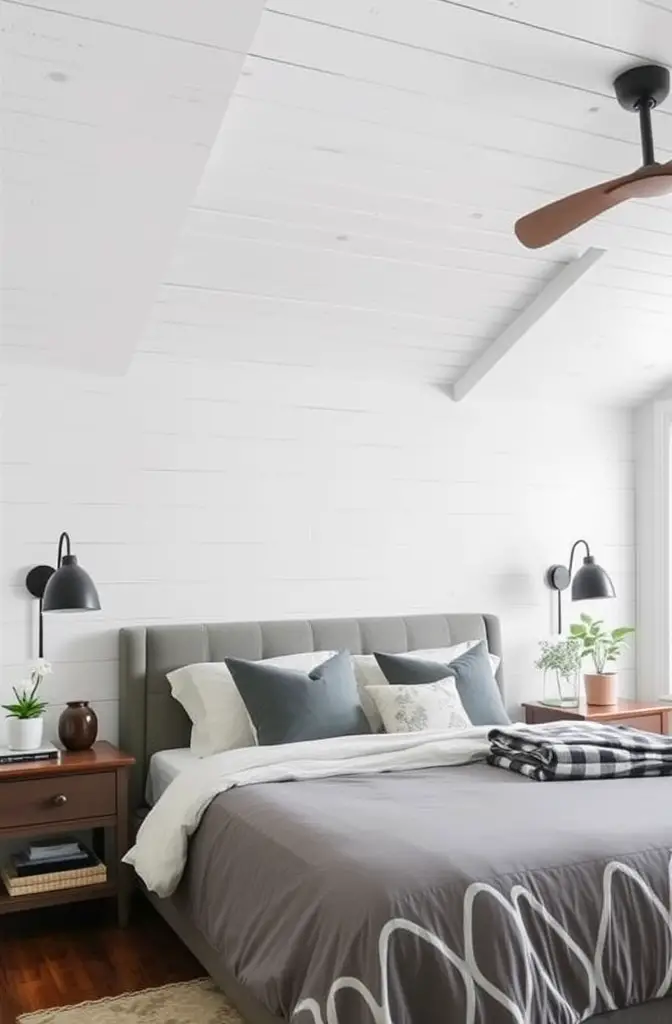
Installing shiplap overhead creates an architectural feature that transforms the entire feel of your room.
The “fifth wall” treatment draws the eye upward, making even modest-sized bedrooms feel more spacious and considered.
Ceiling shiplap creates a beautiful frame for statement lighting fixtures, turning functional elements into artistic focal points.
The overhead texture adds warmth and interest to a surface that’s typically ignored in most bedroom designs.
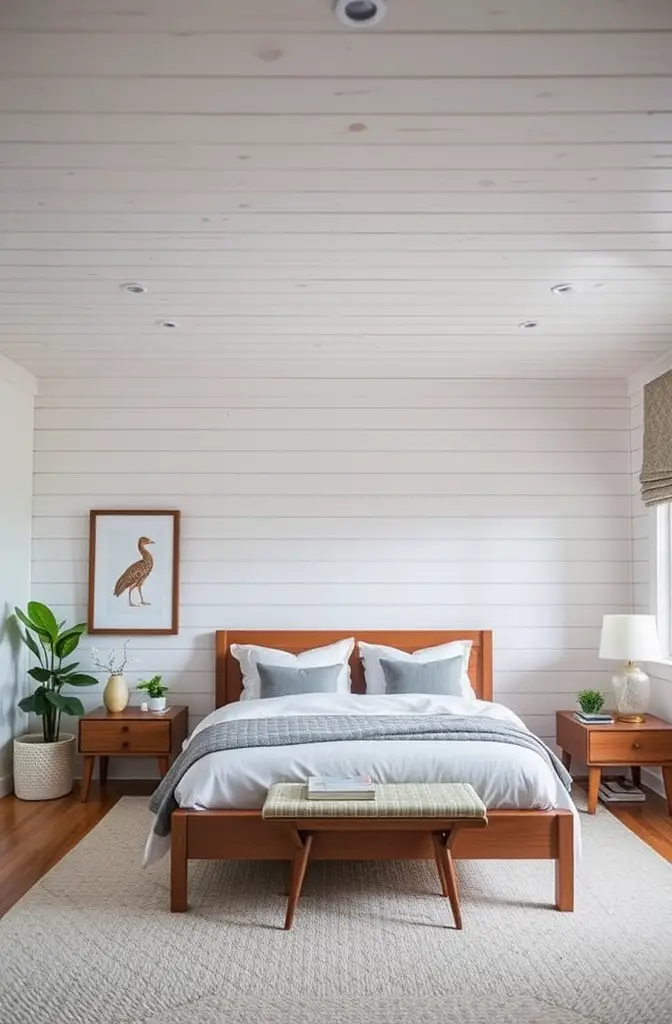
For sloped ceilings or attic bedrooms, continuous shiplap creates cohesion that embraces unusual architecture rather than fighting it.
White ceiling shiplap visually raises your ceiling while stained or dark-painted boards create a cozy, intimate atmosphere.
The linear patterns can visually elongate your bedroom, making narrow spaces feel more balanced and proportioned.
Unlike popcorn or textured ceilings that collect dust, smooth shiplap offers cleaner air quality with classic style.
Ceiling installation requires some additional planning and assistance, but the dramatic impact far outweighs the extra effort.
This approach works particularly well with ceiling fans, creating a custom built-in appearance rather than an afterthought installation.
For modern bedrooms, consider running the boards in the same direction as your floor planking for subtle alignment that registers subconsciously.
The overhead application reflects sound differently than drywall, often improving the acoustic quality of your bedroom.💡
Headboard Alternative: Behind-The-Bed Shiplap Statement
Why spend hundreds on a headboard when your wall can become the statement piece?
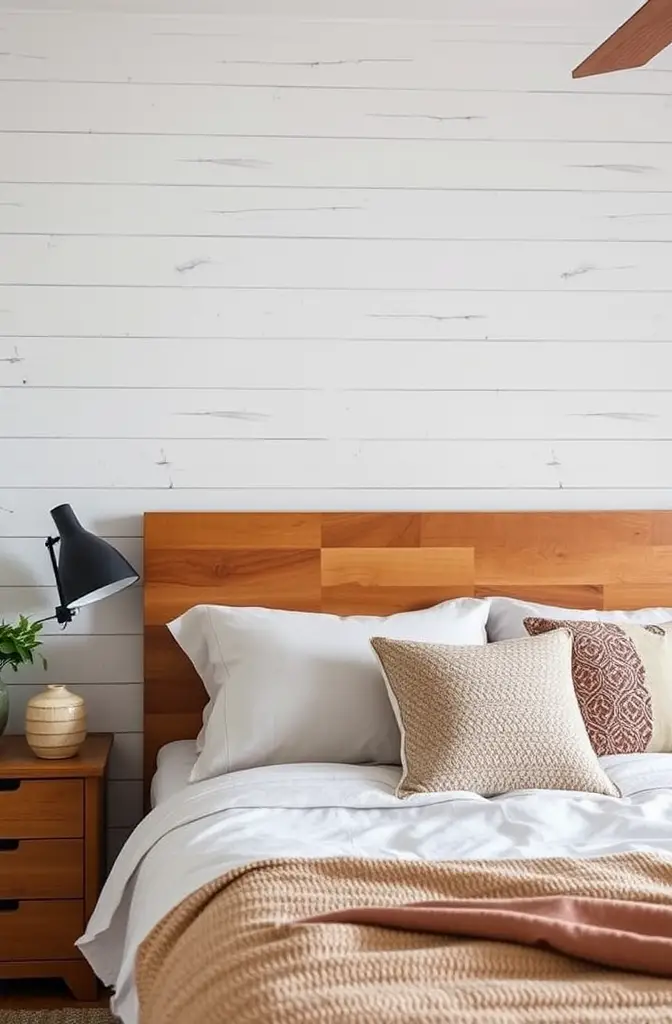
A shiplap installation behind your bed instantly creates a custom backdrop that outshines store-bought headboards.
This targeted approach allows you to create significant impact with minimal materials and installation time.
Consider extending the shiplap a foot wider than your bed on each side for perfectly balanced proportions.
The textural element eliminates the need for extensive artwork or wall decor above your bed.
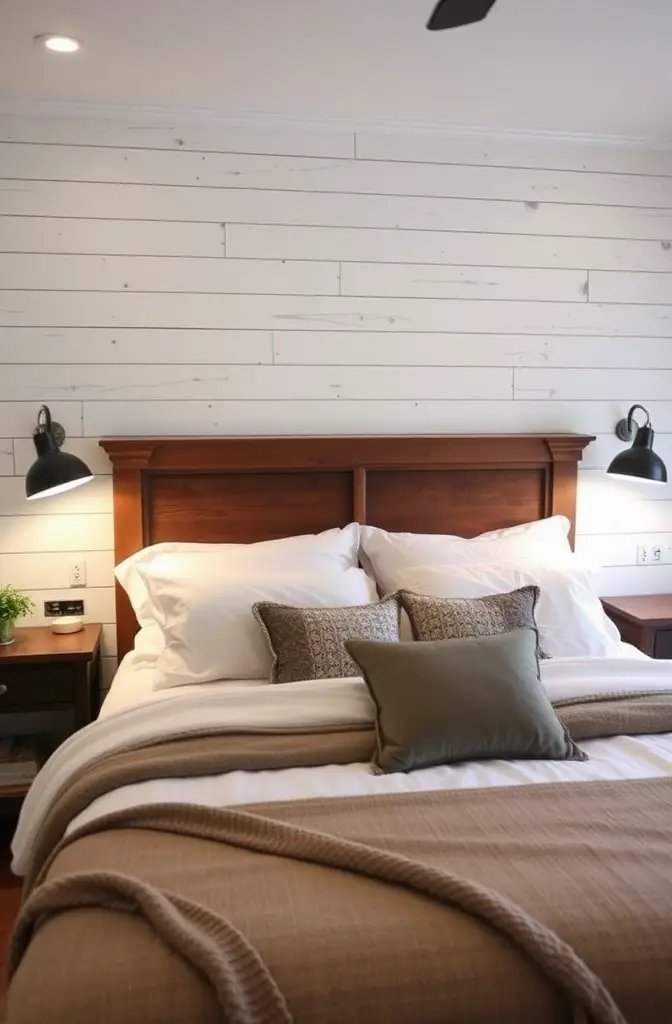
For a truly custom look, install integrated floating nightstands directly onto the shiplap wall.
This technique creates a beautiful, intentional frame for your bed that photographers and interior designers immediately recognize as high-end.
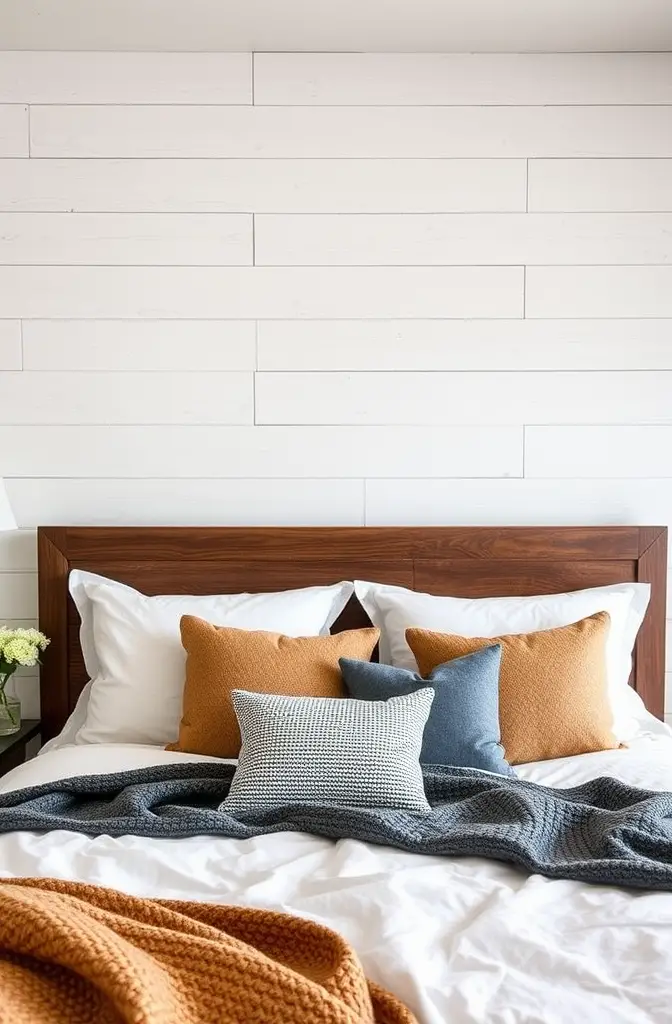
The vertical space becomes your opportunity to play with color, whitewashing, or natural stains that might feel overwhelming elsewhere.
Unlike upholstered headboards that collect dust and can trigger allergies, shiplap offers a cleaner sleeping environment.
The solid backing provides perfect support for reading in bed—just add comfortable pillows directly against the textured wall.
For renters, focusing your shiplap efforts on a single wall minimizes both installation complexity and future removal considerations.
The behind-bed installation creates subtle acoustics that can actually improve sleep quality by softening environmental sounds.
This approach pairs beautifully with wall sconces mounted directly to the shiplap, eliminating the need for table lamps.
✨Click to Get My 101 FREE Designer Room Ideas
Built-In Beauty: Integrated Shiplap Storage Solutions
Transform your bedroom storage from functional necessity to architectural feature with integrated shiplap built-ins 📚

Unlike standard furniture pieces, shiplap-backed shelving and cabinetry appear purposefully designed for your specific space.
The textured backdrop elevates even simple personal items into curated vignettes worthy of design magazines.
Consider flanking your bed with shiplap-backed niches that eliminate the need for conventional nightstands.
The continuous material creates visual flow while still providing essential storage that every bedroom requires.

Window seats become extraordinary when framed with shiplap that continues from the surrounding walls.
This approach allows you to maximize every square inch of bedroom space while maintaining design cohesion.
The built-in strategy creates the custom millwork look of high-end homes without the premium custom cabinetry price tag.
For smaller bedrooms, shiplap built-ins painted the same color as surrounding walls create storage that visually recedes rather than dominates.
Closet interiors lined with shiplap transform utilitarian storage into boutique-worthy dressing spaces.
The additional texture makes even open shelving look intentional and elevated, not simply functional.
Consider incorporating shiplap into the backs of bookshelves or display cases for unexpected detail that showcases your personal items.
The natural wood element brings warmth to what might otherwise feel like sterile storage solutions.
This integrated approach creates that coveted “everything in its place” feeling that contributes to peaceful sleep environments.
😌
Reclaimed Character: Sustainable Shiplap With History
Nothing compares to the authentic patina and character of genuine reclaimed wood shiplap. 🌲

Each board tells a story with its weathered surface, nail holes, and imperfect edges that modern reproductions simply cannot match.
The environmental benefits are substantial—you’re giving new life to materials that might otherwise end up in landfills.
The varied coloration in reclaimed boards creates natural dimension that new lumber requires significant effort to replicate.
These historical pieces bring subtle energy to your bedroom—the feeling of sleeping surrounded by stories and history.
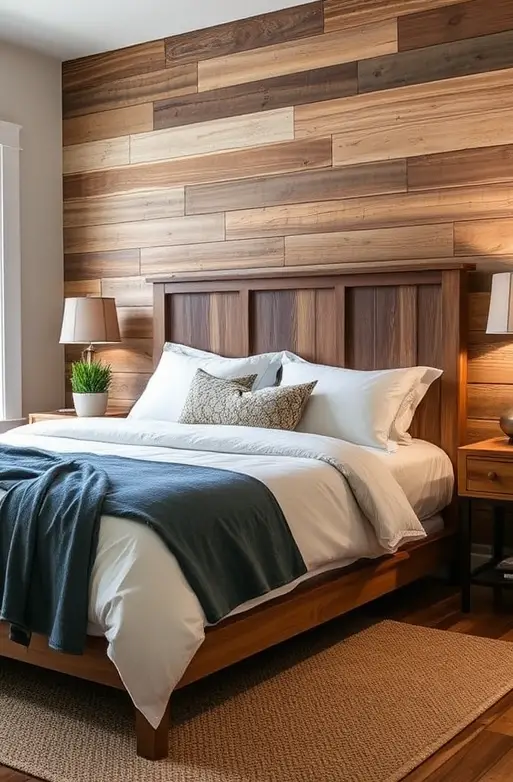
Many reclaimed boards come from century-old barns, factories, and buildings with decades of character already built in.
The imperfections become features rather than flaws—each knot, crack, and variation adding to the overall appeal.
For authentic farmhouse style, nothing beats the real thing with its genuine aged patina and natural variation.
While initially more expensive than new lumber, reclaimed wood often becomes a one-time investment that appreciates in both value and character.
The natural weathering process creates colors and textures that designers try desperately to simulate with expensive finishing techniques.
For health-conscious homeowners, older-growth timber often contains fewer chemicals than many modern building materials.
The structural stability of aged wood has already been proven through decades of real-world testing in previous applications.
The unique character creates a truly one-of-a-kind bedroom that cannot be replicated—even by neighbors using the same design concept.
This sustainable choice often becomes a conversation piece that connects your personal space to broader environmental values.
🌎
Pattern Play: Herringbone and Chevron Shiplap Installations
Ready to take your shiplap game to the next sophistication level? Diagonal patterns change everything! 📐

The unexpected angles of herringbone or chevron installations immediately signal custom, high-end design intent.
These patterns transform simple wood boards into mathematical art that draws the eye and holds attention.
The directional movement creates dynamic energy that standard horizontal or vertical installations simply cannot achieve.
Chevron patterns (where boards meet at perfect points) create formal elegance while herringbone (with offset joints) offers slightly more casual sophistication.
These installations require more precise cutting and additional material for waste, but the dramatic results justify the extra effort.
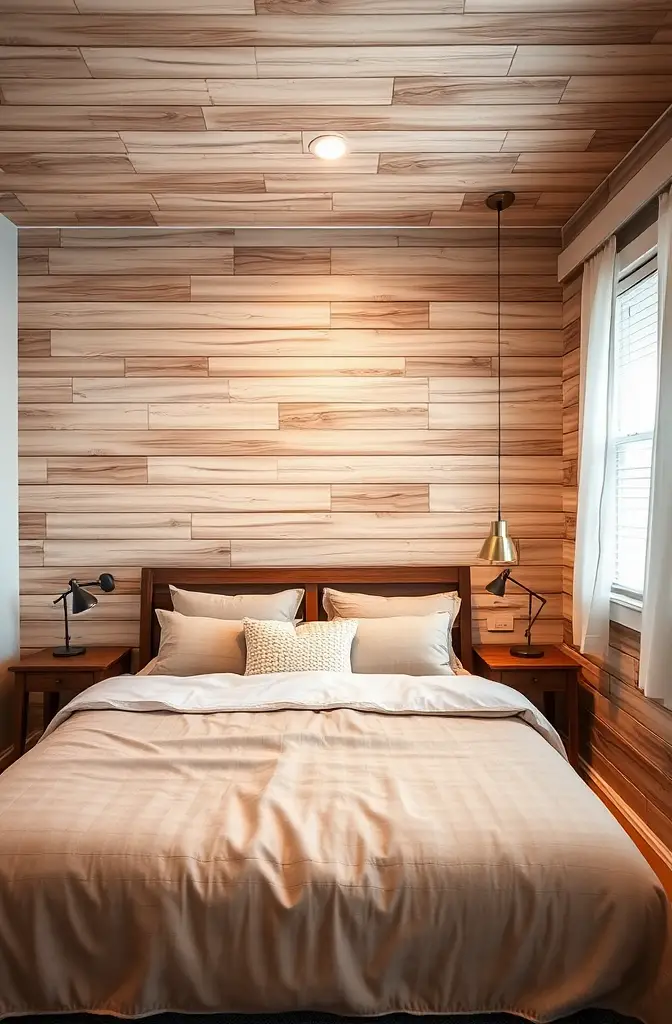
The diagonal orientation naturally draws the eye upward and outward, making bedrooms feel larger and more expansive.
For maximum impact, consider installing pattern-oriented shiplap on the ceiling where it creates unexpected architectural interest.
The sophisticated arrangements pair beautifully with both minimalist modern furniture and traditional bedroom pieces.
These patterns have historical roots in European design traditions, bringing timeless elegance to contemporary spaces.
Consider painting the patterned installation in unexpected colors like deep emerald or navy for truly show-stopping results.
The geometric precision creates beautiful contrast against softer bedroom elements like plush bedding and curved furniture.
Even smaller pattern installations—perhaps just in a dressing nook or reading corner—create significant design impact.
Dark Drama: Black and Charcoal Shiplap for Bold Bedrooms
Dare to step away from the expected with the dramatic impact of dark-painted shiplap 🖤

Deep charcoals, rich navies, and true blacks transform humble wood planks into sophisticated architectural statements.
The shadow lines between boards become even more pronounced with dark colors, creating dramatic texture even in minimal light.
This bold approach pairs surprisingly well with both vibrant jewel tones and soft neutrals for versatile styling options.

Dark shiplap creates a perfect backdrop for making metallic accents like brass lamps or gold frames truly pop.
The cocooning effect of dark walls has been proven to create better sleep environments by minimizing visual distraction.
Unlike flat painted walls which can appear one-dimensional in dark colors, shiplap provides natural texture that adds depth.
The unexpected combination of rustic texture with sophisticated dark colors creates an intriguing design tension.
Dark shiplap particularly shines in bedrooms with abundant natural light where the texture remains visible throughout the day.
For maximum impact, consider painting trim and ceiling the same dark shade for a fully immersive, envelope-like effect.
The dramatic backdrop makes white bedding appear even crisper and more inviting through strong contrast.
Even small bedrooms can handle dark shiplap when strategically balanced with proper lighting and reflective surfaces.
Designers frequently use this technique to create instant atmosphere in bedroom spaces that lack architectural interest.
✨Click to Get My 101 FREE Designer Room Ideas
Budget-Friendly Brilliance: Partial Height and Panel Applications
Looking for maximum impact with minimum budget? Partial shiplap applications deliver designer results without breaking the bank 💰
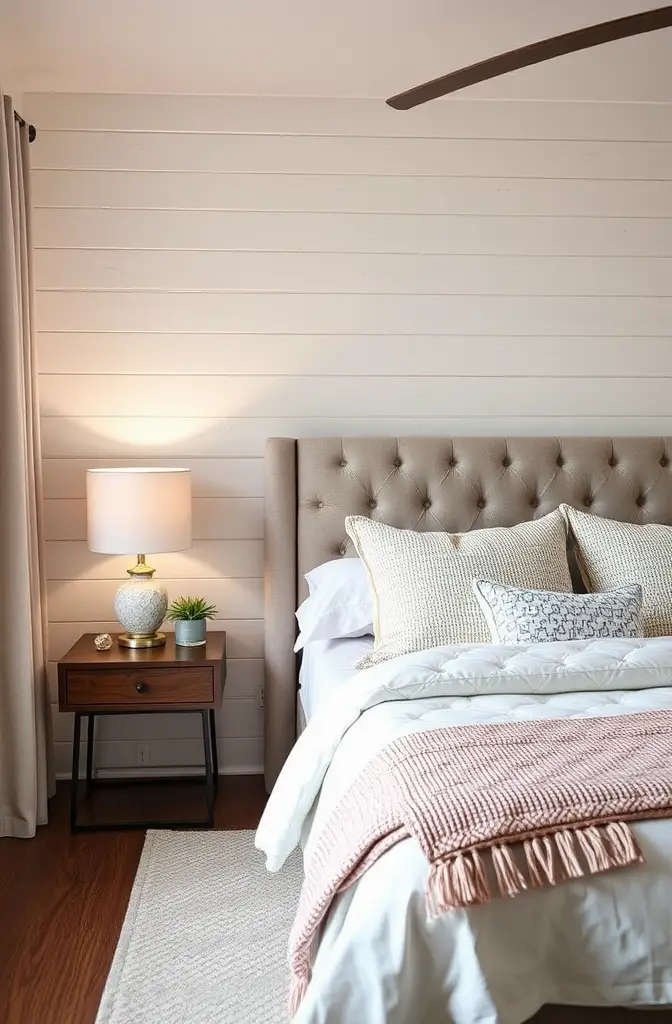
Consider a chair-rail height installation that provides all the character with just half the materials and installation time.
This approach creates clear visual zoning in your bedroom while allowing for complementary paint or wallpaper above.
Partial height applications work particularly well behind dressers and vanities where full-height installation would be partially obscured anyway.
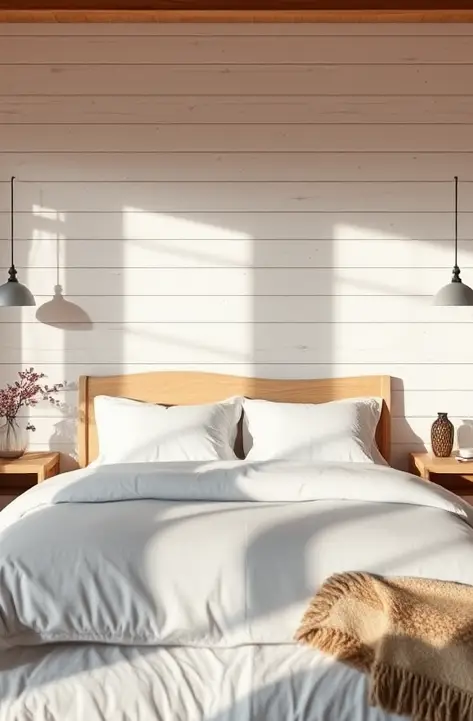
The horizontal boundary created by ending shiplap mid-wall adds an architectural detail that basic drywall bedrooms typically lack.
This technique creates the perfect opportunity for two-tone color stories—perhaps darker below and lighter above.
For bedrooms with already-busy design elements, the partial application adds texture without overwhelming the space.
The lower application height often eliminates the need for electrical outlet adjustments, simplifying DIY installation considerably.
Consider this approach for rental properties where you want maximum style with minimum permanent commitment.
The partial height creates a perfect perch for hanging artwork or mirrors that seem intentionally framed by the textural change.
For awkwardly shaped bedrooms, partial applications can visually correct proportion problems by creating a strong horizontal line.
This approach allows you to invest in higher quality materials for the visible portion while maintaining overall budget constraints.
The split-wall technique dates back centuries in traditional design, bringing timeless appeal to contemporary bedrooms.
For first-time DIYers, the lower height installation means less ladder work and easier management of board alignment.
🔨
I hope these ideas inspire you to see shiplap as more than just a passing trend!

